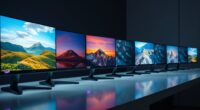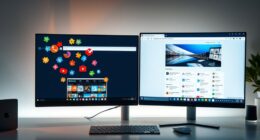Prolonged screen time can cause eye strain and discomfort, leading to symptoms like dryness, headaches, blurred vision, and light sensitivity. To protect your eyes, follow practical tips such as taking regular breaks using the 20-20-20 rule, adjusting your screen brightness, and ensuring proper lighting. Blink often, use artificial tears, and set your screen to blue light filters. Staying aware of these habits helps prevent long-term damage—keep going to learn more about safeguarding your vision.
Key Takeaways
- Follow the 20-20-20 rule: every 20 minutes, look at something 20 feet away for 20 seconds.
- Adjust screen brightness and use blue light filters to reduce eye irritation during prolonged use.
- Create an ergonomic workspace with proper monitor height, distance, and ambient lighting to minimize strain.
- Blink frequently and use artificial tears to keep eyes moist and prevent dryness and discomfort.
- Recognize symptoms like headaches, blurred vision, or eye redness early, and seek professional eye care if they persist.
Understanding Eye Strain and Its Causes
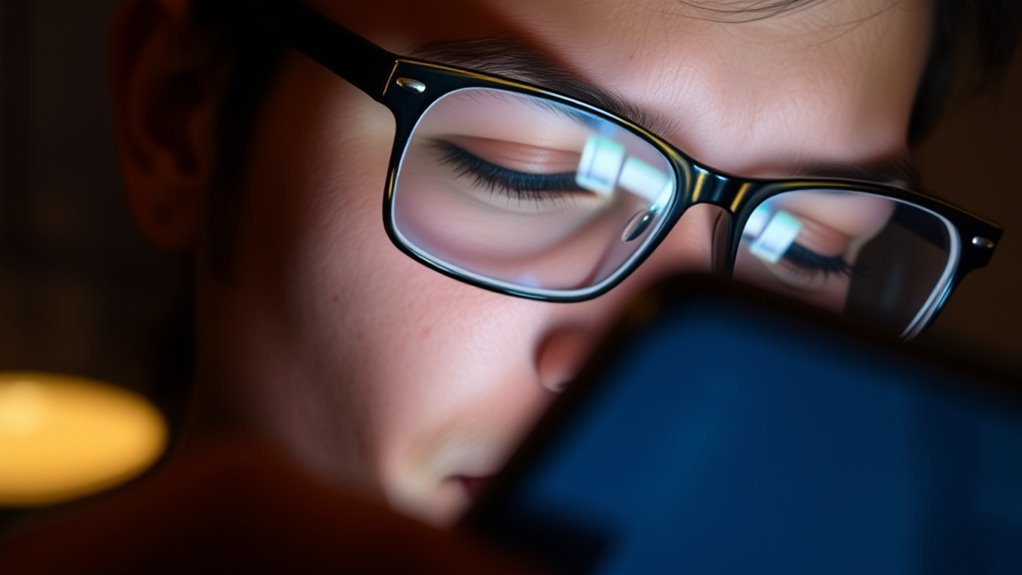
Eye strain, also known as digital eye strain or computer vision syndrome, occurs when your eyes become fatigued from prolonged screen use. One major cause is blue light exposure, which can irritate your eyes and disrupt your sleep patterns. Additionally, focusing on screens for extended periods causes eye muscle fatigue, as your eye muscles work harder to maintain clarity and focus. You might notice symptoms like dryness, headaches, or blurred vision. These issues happen because your eyes aren’t given enough breaks, leading to strain and discomfort. To minimize this, it’s crucial to be aware of your screen time and take regular breaks, allowing your eyes to rest and recover from the constant focusing and blue light exposure. Understanding eye health and implementing proper habits can help prevent long-term vision problems. Incorporating screen ergonomics can further reduce eye strain by optimizing your viewing environment. Being mindful of focal distance and maintaining proper lighting conditions can also contribute significantly to reducing eye fatigue. Using headphones to listen to audio without turning your head toward screens can also help reduce overall eye strain by promoting a more comfortable viewing posture. Additionally, adjusting your screen brightness to match ambient lighting can greatly lessen eye discomfort during prolonged use.
The Impact of Prolonged Screen Use on Vision
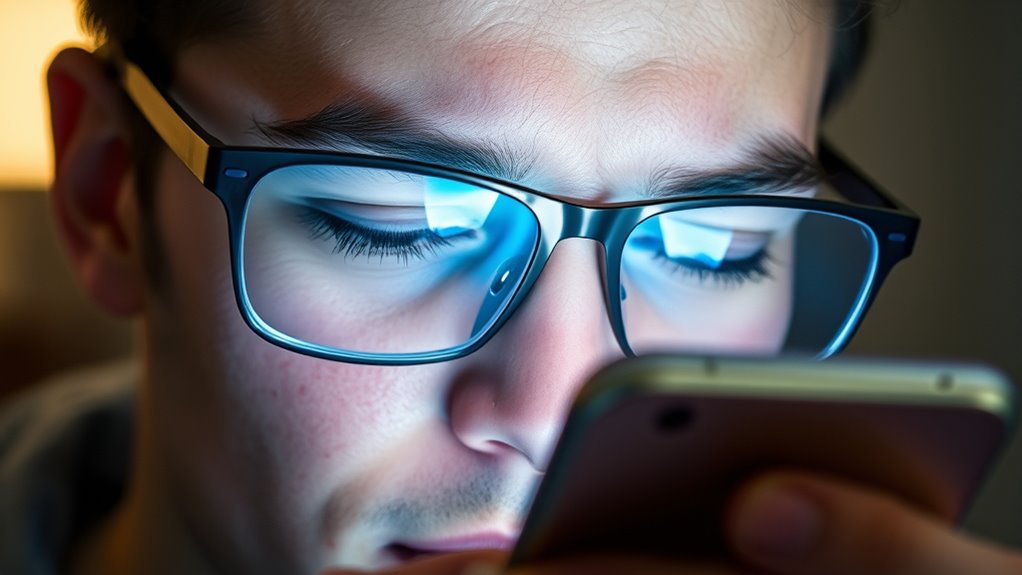
When you spend long hours staring at screens, your eyes can become strained and tired. Reduced blinking causes dryness and discomfort, making it harder to see clearly. Over time, this can lead to more serious vision issues that may affect your sight in the future. Regular breaks and proper screen time management can help alleviate some of these problems. Additionally, emerging concerns about AI safety vulnerabilities highlight the importance of being aware of technological impacts on health and safety. Practicing eye exercises and maintaining proper lighting conditions can further reduce eye strain during prolonged screen use. Proper air quality in your environment can also contribute to overall eye comfort, especially in areas with poor ventilation. Incorporating awareness of patch testing and gentle exfoliation may also help in maintaining healthy skin around your eyes and face.
Digital Eye Strain
Prolonged screen use can lead to digital eye strain, a condition that causes discomfort and vision problems after extended periods of staring at digital devices. You might notice headaches, blurred vision, or dry eyes. To reduce these symptoms: 1. Limit blue light exposure by using screen filters or glasses. 2. Keep your eyes hydrated by blinking often and using artificial tears if needed. 3. Adjust your screen brightness to match ambient lighting. 4. Take regular breaks to rest your eyes and prevent strain. Additionally, choosing devices with optimized display settings can help reduce eye fatigue during long sessions. Being aware of eye strain symptoms and how to manage them can significantly improve your comfort. These steps help minimize eye fatigue and maintain your eye health. Remember, reducing blue light exposure and staying hydrated are key to fighting digital eye strain and protecting your vision during long screen sessions. Incorporating proper lighting conditions into your environment can further reduce eye strain and enhance overall comfort.
Reduced Blink Rate
Extended screen time often leads to a reduced blink rate, which can substantially impact your eye health. When you focus on screens, you tend to blink less frequently, sometimes by half. This decrease in blinking reduces tear production, leaving your eyes more exposed and prone to dryness. Without enough tears to lubricate your eyes, you may experience discomfort, irritation, and blurred vision. A lower blink rate also means your tears evaporate faster, further dry out your eyes, and compromise the protective tear film. To counteract this, consciously remind yourself to blink more often and take regular breaks. Incorporating proper blinking techniques can help maintain your eye’s moisture and overall comfort during prolonged screen use. Additionally, practicing vision-friendly habits and understanding the importance of emotional support can help mitigate these effects and support long-term eye health.
Long-term Vision Risks
Long-term screen use can cause significant damage to your vision over time. Prolonged exposure may accelerate age-related changes, especially if you have genetic predispositions. Over years, you might face issues like increased eye strain, worsening visual clarity, or developing conditions such as myopia or dry eyes. To minimize risks, consider these factors:
- Genetic predispositions that make your eyes more vulnerable to damage.
- Age-related changes that naturally shift your vision and require regular eye exams.
- The risk of developing digital eye strain that worsens with continued screen time.
- The potential for progressive deterioration if you ignore early warning signs or neglect eye health strategies.
Being proactive helps protect your long-term vision, especially as your eyes adapt to age and genetic factors.
Recognizing Symptoms of Digital Eye Strain
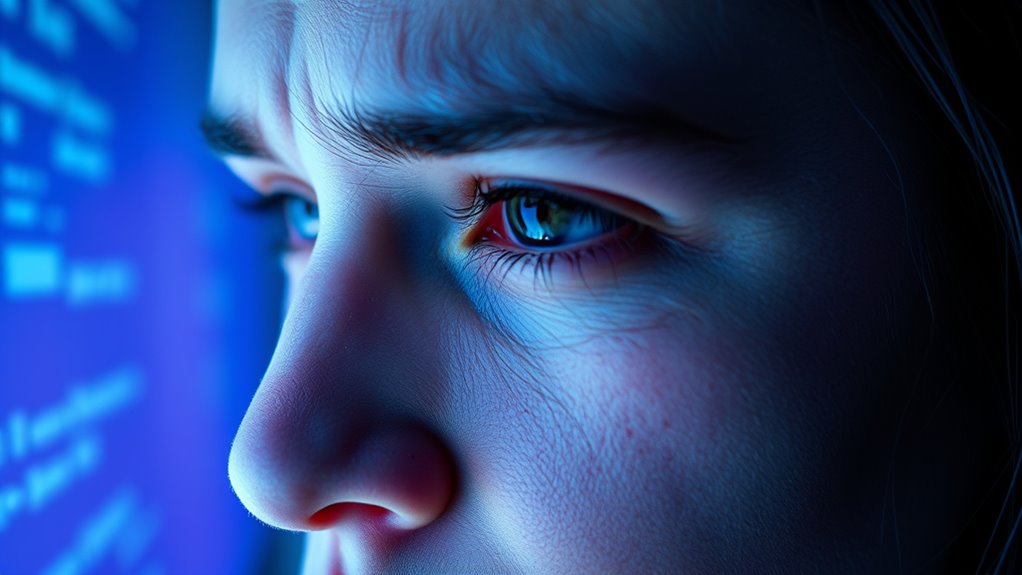
You might notice eye discomfort, like dryness or soreness, after long hours in front of a screen. Headaches and tiredness are also common signs that your eyes are strained. Additionally, blurry vision or difficulty focusing can signal digital eye strain needs your attention. Incorporating ergonomic design principles can help reduce the risk of eye fatigue during extended screen time. Ensuring proper screen positioning and appropriate lighting can further minimize strain. Being aware of decoding slang can also help you better understand informal language used in digital communication. Recognizing special occasions can remind you to take breaks and celebrate small moments of well-being amidst busy schedules. Staying informed about AI advancements can further support the development of tools aimed at reducing digital eye strain.
Eye Discomfort Signs
Digital eye strain often reveals itself through a variety of discomfort signs that can easily be overlooked. You might notice eye discomfort that feels like dryness, burning, or itchiness after extended screen use. Vision fatigue is another common sign, making your eyes feel heavy or tired even after short periods. To better identify these symptoms, watch out for:
- Red or watery eyes
- Blurred or double vision
- Sensitivity to light
- Difficulty focusing after screen time
These signs indicate your eyes are struggling to adapt to prolonged digital exposure. Recognizing eye discomfort and vision fatigue early helps you take steps to protect your vision and reduce long-term strain. Pay attention to these symptoms to prevent further discomfort.
Headaches and Fatigue
Eye discomfort and vision fatigue often lead to more noticeable symptoms like headaches and tiredness. If you spend long hours in front of screens, you may notice persistent headaches, especially after extended use. Fatigue sets in as your eyes strain from constant focus and blue light exposure. To prevent this, prioritize eye strain prevention techniques, like taking regular breaks and adjusting screen brightness. Recognize these signs early to avoid worsening symptoms. Additionally, understanding the impact of Health – Greek Sceptic can help you adopt healthier habits for your eyes.
Blurred Vision Symptoms
Blurred vision is a common sign that your eyes are strained from prolonged screen time. When your eye muscles fatigue, your visual clarity diminishes, making it hard to focus sharply. Recognizing these symptoms early helps protect your eye health. Watch out for:
- Difficulty focusing on nearby objects
- Blurred or fuzzy vision that comes and goes
- Eyes feeling tired or heavy after screen use
- Double vision or overlapping images
If you notice any of these signs, take breaks and adjust your screen settings. Proper eye care can reduce digital eye strain and maintain clear vision. Staying aware of blurred vision symptoms ensures you catch problems early and support your overall eye health.
Practical Tips to Reduce Eye Fatigue

To effectively reduce eye fatigue, you should adopt simple daily habits that lessen strain during screen time. First, create an ergonomic workspace by adjusting your chair, monitor height, and distance so your eyes are aligned comfortably with the screen. This setup minimizes unnecessary eye movement and reduces strain. Second, set screen time limits to prevent prolonged exposure; take breaks every 20 minutes by looking at something 20 feet away for at least 20 seconds. Also, blink frequently to keep your eyes moist and avoid dryness. Consider using artificial tears if needed. Incorporating these practical tips helps protect your vision and keeps eye fatigue at bay. Small adjustments in your daily routine can make a significant difference in maintaining comfortable, healthy eyes.
The Role of Proper Lighting and Screen Settings
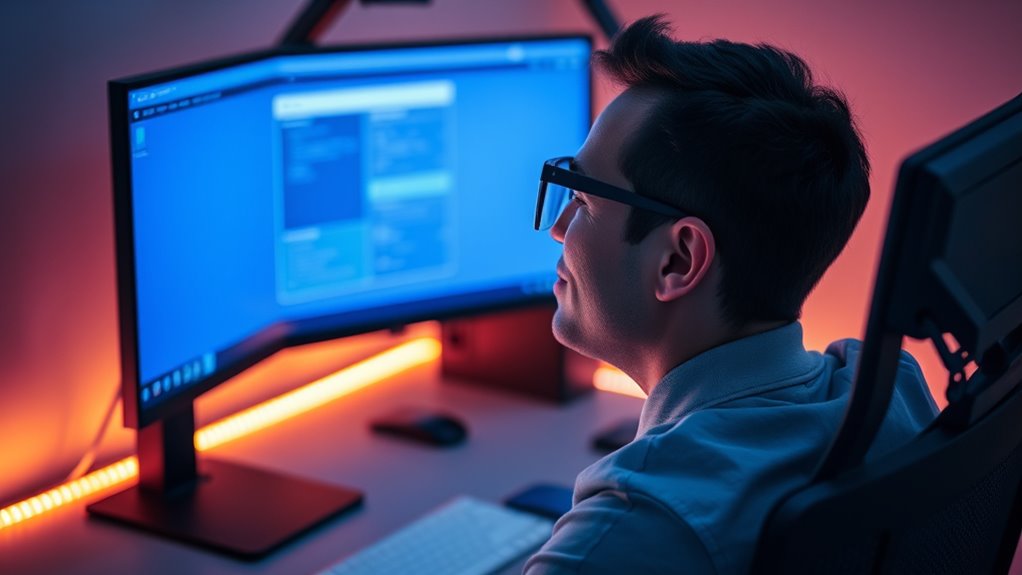
Proper lighting and ideal screen settings are essential for reducing eye strain during prolonged screen use. Adjusting ambient lighting helps prevent glare and harsh contrasts, making viewing more comfortable. Keep your screen brightness in balance with surrounding light—neither too bright nor too dim—to reduce eye fatigue. Here are four key tips:
Proper lighting and screen settings help prevent eye strain during long screen time.
- Use soft, ambient lighting to minimize screen glare.
- Match your screen brightness to the ambient light level.
- Avoid reflections by positioning your screen away from windows or bright lights.
- Enable blue light filters or night mode to lessen eye strain during extended use.
Implementing these adjustments guarantees your eyes stay comfortable and protected, especially during long hours in front of screens. Proper lighting and screen settings are crucial for maintaining good eye health.
The Importance of Regular Eye Breaks
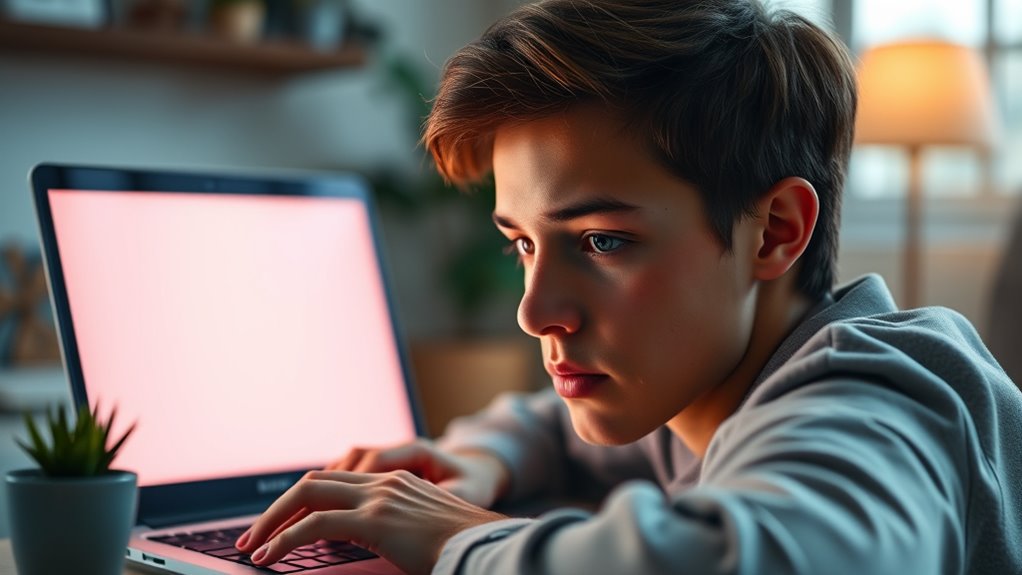
Since spending long hours in front of screens can strain your eyes, taking regular breaks is essential to keep your vision healthy. Incorporate eye exercise routines during breaks to relax eye muscles and reduce fatigue. Every 20 minutes, look away from your screen for at least 20 seconds and focus on a distant object. Consider using blue light filtering glasses or screen settings to minimize blue light exposure, which can contribute to eye strain. These breaks help prevent discomfort, headaches, and blurred vision. Remember, consistency is key—make eye breaks a daily habit. Not only do they give your eyes a rest, but they also help maintain overall eye health, especially during long screen sessions. Regular eye breaks are a simple yet effective way to protect your vision.
When to Seek Professional Eye Care
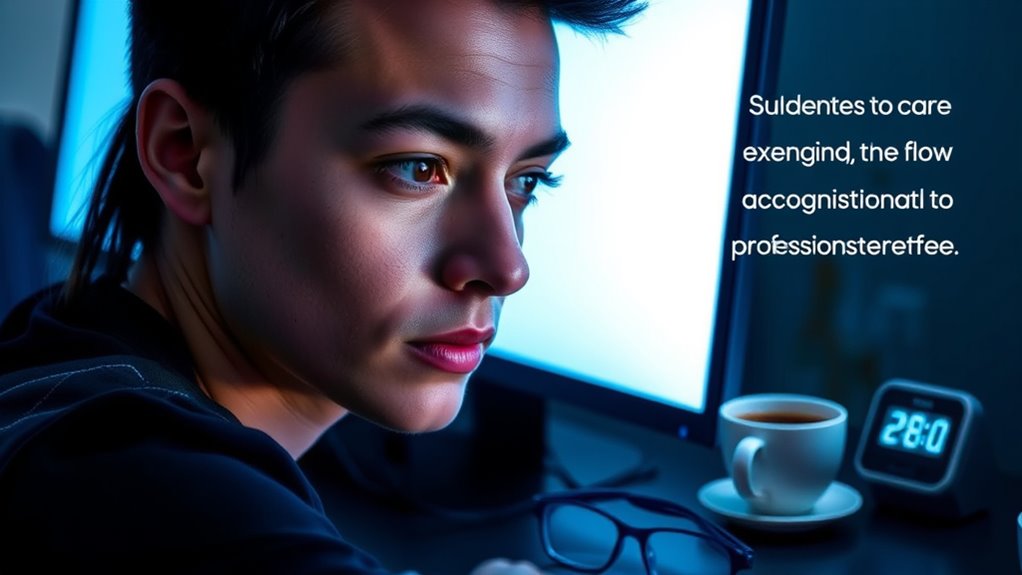
Even with regular eye breaks, certain warning signs indicate you should see an eye care professional promptly. If you experience persistent headaches, blurred vision, eye redness, or discomfort, it’s time for an eye exam. These symptoms can signal the need for vision correction or other eye issues that require professional attention. Don’t overlook sudden changes in your vision or difficulty focusing, as these could worsen without proper care. Regular eye exams help detect problems early and ensure your prescription stays up-to-date. Additionally, if you notice glare or halos around lights, it might be a sign to seek help. Prioritize your eye health to maintain clear vision and prevent long-term damage. Remember, early intervention is key to protecting your sight.
Frequently Asked Questions
How Can Ergonomic Workspace Setup Improve Eye Comfort?
An ergonomic workspace setup can greatly improve your eye comfort by ensuring your monitor height is at eye level, reducing strain from looking up or down. Using an ergonomic chair supports proper posture, helping you stay relaxed and focused. Adjust your monitor so it’s about an arm’s length away, and maintain good lighting. These small changes prevent eye fatigue and make your workspace more comfortable overall.
Are There Specific Glasses That Protect Against Blue Light?
Think of blue light glasses as your shield in the digital battlefield. Yes, these glasses often come with anti-reflective coatings that reduce glare, making it easier for you to focus. They’re specifically designed to block or filter blue light emitted by screens, helping to lessen eye strain and protect your vision over time. So, investing in a good pair of blue light glasses can be a smart move for your eye health.
What Are Long-Term Effects of Ignoring Digital Eye Strain?
Ignoring digital eye strain can lead to serious long-term effects. You might experience vision deterioration over time, making it harder to focus or see clearly. Chronic eye discomfort can also develop, causing headaches, blurred vision, and fatigue. If you don’t take steps to protect your eyes now, these issues could worsen, impacting your daily life and overall eye health. It’s essential to address eye strain early to prevent lasting damage.
Can Diet Influence Eye Health Related to Screen Time?
Think of your eyes as a garden that needs nourishment to stay healthy. Your nutrient intake and dietary habits are like watering and fertilizing that garden. Eating foods rich in vitamins A, C, and E, along with omega-3s, can strengthen your eye health amid screen time. By maintaining good diet choices, you help protect your vision, ensuring your eyes stay vibrant and resilient against digital strain.
How Do Age and Pre-Existing Conditions Affect Digital Eye Strain Risk?
Age-related changes and pre-existing conditions can increase your risk of digital eye strain. As you age, your eyes may become less flexible and produce fewer tears, making them more sensitive to screens. If you have pre-existing conditions like dry eye or glaucoma, these can worsen discomfort or strain. Staying mindful of these factors helps you take proactive steps, such as regular eye checkups and proper screen habits, to protect your vision.
Conclusion
By taking these simple steps, you can shield your eyes like a sturdy fortress against the relentless wave of screen time. Imagine your vision as a delicate garden—tend to it with proper lighting, regular breaks, and mindful habits, and it’ll flourish bright and clear. Don’t let digital strain turn your vibrant view into a faded painting. Protect your sight now, and keep your world crisp, colorful, and full of life.


